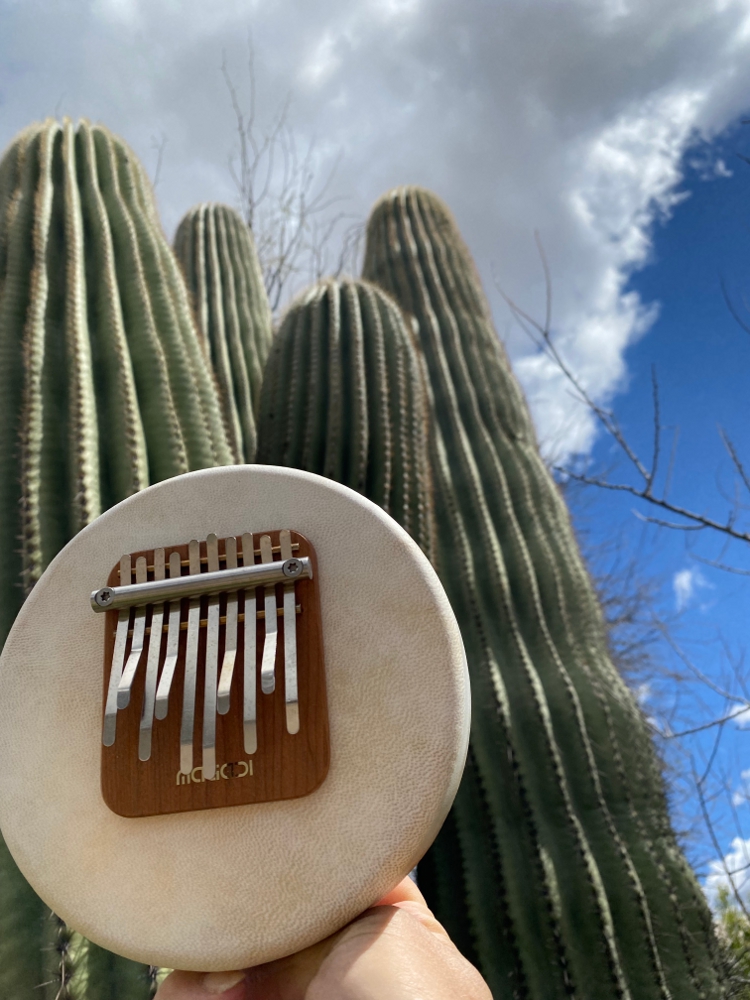
Use of this website constitutes acceptance of the Privacy Policy and User Agreement. Copyright © 2020 Kalimba Magic. All Rights Reserved.
A few years ago, I saw a 10-year-old girl flipping her cup to this song, and I have to admit I was blown away by how well she was doing it. Last month when I found the video for Anna Kendrick’s pop song “When I’m Gone” and connected it to the cup routine I’d seen some years before, I suddenly understood why this video has 300 million views – it takes dozens of views to learn how to do that cup jive!
I put in my dozens of views – but it wasn’t to learn the cup trick. I was, at first, freeform jamming along on the kalimba. But slowly, the more I played with this song, the more my playing settled down into a repeatable part. And that’s what I share with you here.
The video playing at the bottom of the page is a skit of Anna Kendrick singing “When I’m Gone” (of which “Cups” is a version) as she plays a waitress in a diner. The action takes a while to get started, but it’s quite a joy-inspiring little trip, if you’ve never seen it. It features this cool rhythmic routine involving hands, a table, and a drinking cup. The routine is done by a few people here and there in the beginning, and ultimately by all 30 people sitting at the diner’s counter and all its tables too.
Down at almost the bottom of this page there is another video, just above the “Cups” video, and if you stop that one and start mine, you’ll see that it’s me demonstrating the kalimba accompaniment I wrote to go along with “When I’m Gone”.
I wrote this when a friend of mine asked me if I could make up a kalimba part for this song. It is based on the riff shown in the tablature above. The song is in the key of C, so it was a natural choice to go with the C-Alto (a standard G-tuned Alto kalimba, but with the two F# tines tuned down to F). I like to put black dots on the two C tines just to remind me where the root notes are. Those black dots are also great for telling me right away that I am not holding a normal G-tuned Alto.
The rhythm of the riff shown above is like “Pop Pop Stick ’em up Cow-boy Joe | One Two Three One Two Three HOLD,” and it fits great with the rhythmic cups thing as well as with the first few phrases of the verse. The second line of the verse (“the one with the prettiest of views”) has a chord change, but the part I wrote keeps sitting on this riff. I think it does work, but it also will cut the listener’s expectations for the kalimba part – like the kalimba player is saying “Hey, I only know one riff – it’s a good riff and I’m sticking to it.” A lot of people play kalimba this way. However, in the very next phrase, I follow the chords exactly in a descending kalimba line – in other words, I really come through with the goods, and if anyone was fooled by the constant riff that is repeated several times in the intro and the beginning of the verse, they will be blown away by the kalimba that knows how to follow the song so closely.
That is a general rule for music – don’t give it all away at once. Play something solid but simple, to lower audience expectations, and then hit it harder. But do hold back. And I do hold back, until everyone in the diner is doing the cup jive, and then my kalimba part peaks right alongside the music. Always leave some headroom at the top so you can get a bit bigger and more impressive. But also, don’t push it – if you try to go oh-so-high and find that you are trying to play beyond your abilities, you just lost some of your audience by being sloppy, over-the-top, and not coming through with what your buildup promised.
On the other hand (so much for general rules), nothing compares to the feeling you get when you take a risk and go a little beyond what you thought you could do – and somehow the heat of the moment comes through for you and you are flying, exceeding your own expectations – and you will be so joyful and happy that the audience will recognize that something remarkable just happened, and you have exceeded their expectations and you won them over!
Here is my kalimba accompaniment to “When I’m Gone”.
Download Tablature for C Alto / “When I’m Gone”
See the “Cups” video and hear Anna Kendrick singing “When I’m Gone” without the benefit of a kalimba:


Sign up for our newsletter and free resources with your email address:
We pinky promise not to spam you and to only send good stuff.
 Assist Paul Tracey Rebuild His House in Pacific Palisades
Assist Paul Tracey Rebuild His House in Pacific Palisades 8-Note Spiral Kalimba Turned into a Student Karimba
8-Note Spiral Kalimba Turned into a Student Karimba Seek to Infuse Your Musical Moments With Beauty and Magic
Seek to Infuse Your Musical Moments With Beauty and MagicUse of this website constitutes acceptance of the Privacy Policy and User Agreement. Copyright © 2020 Kalimba Magic. All Rights Reserved.